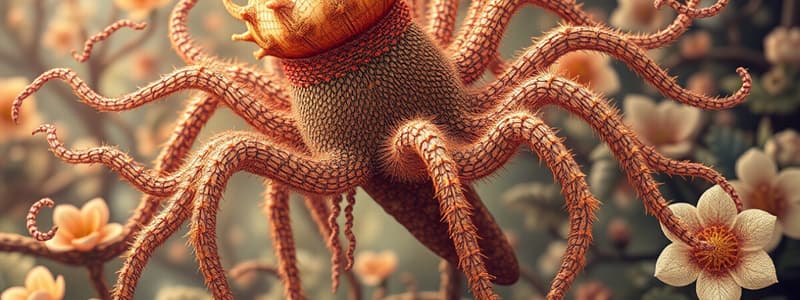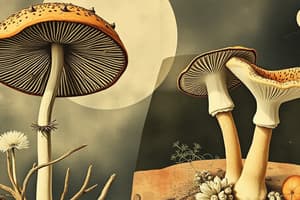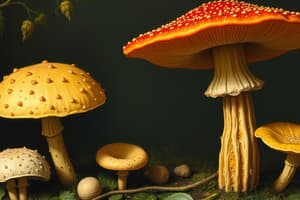Podcast
Questions and Answers
Which of the following is a feature of Domain Eukarya?
Which of the following is a feature of Domain Eukarya?
- Presence of mitochondria (correct)
- Absence of a cytoskeleton
- Genome composed of a single chromosome
- Lack of membrane-enclosed nucleus
All protists are unicellular organisms.
All protists are unicellular organisms.
False (B)
What is mixotrophy in protists?
What is mixotrophy in protists?
the ability to switch between photosynthesis and heterotrophy
Resistant cells called _______ can be produced to endure harsh conditions by some protists.
Resistant cells called _______ can be produced to endure harsh conditions by some protists.
Match the following protist groups with their ecological roles:
Match the following protist groups with their ecological roles:
What is a key characteristic of eukaryotic cilia and flagella?
What is a key characteristic of eukaryotic cilia and flagella?
Protists are a monophyletic group.
Protists are a monophyletic group.
What is the endosymbiotic theory?
What is the endosymbiotic theory?
The supergroup _______ includes diplomonads, parabasalids, and euglenozoans.
The supergroup _______ includes diplomonads, parabasalids, and euglenozoans.
Match the organism with their characteristics?
Match the organism with their characteristics?
What is a defining characteristic of euglenozoa?
What is a defining characteristic of euglenozoa?
Giardia intestinalis transmits disease through contact with skin.
Giardia intestinalis transmits disease through contact with skin.
How does Trypanosoma evade the immune system?
How does Trypanosoma evade the immune system?
Organisms in the supergroup SAR clade are thought to have obtained their plastids through secondary _______ of red algae.
Organisms in the supergroup SAR clade are thought to have obtained their plastids through secondary _______ of red algae.
Match the following SAR clade groups with their characteristics:
Match the following SAR clade groups with their characteristics:
What is the cell wall of diatoms made of?
What is the cell wall of diatoms made of?
Brown algae are primarily unicellular organisms.
Brown algae are primarily unicellular organisms.
What specialized structures do brown algae possess?
What specialized structures do brown algae possess?
_______ are characterized by having membrane-bound sacs (alveoli) under the plasma membrane.
_______ are characterized by having membrane-bound sacs (alveoli) under the plasma membrane.
Match following terms?
Match following terms?
What causes paralytic shellfish poisoning?
What causes paralytic shellfish poisoning?
Apicomplexans are primarily free-living organisms.
Apicomplexans are primarily free-living organisms.
What is the function of cilia in ciliates?
What is the function of cilia in ciliates?
Foraminiferans have porous shells, called _______, made of calcium carbonate.
Foraminiferans have porous shells, called _______, made of calcium carbonate.
Match the features with the correct Rhizarian clade?
Match the features with the correct Rhizarian clade?
What material reinforces the pseudopodia of radiolarians?
What material reinforces the pseudopodia of radiolarians?
Cercozoans are exclusively autotrophic organisms.
Cercozoans are exclusively autotrophic organisms.
What is a common characteristic of supergroup Archaeplastida?
What is a common characteristic of supergroup Archaeplastida?
_______ algae contain phycoerythrin as an accessory pigment, enabling them to absorb blue and green light.
_______ algae contain phycoerythrin as an accessory pigment, enabling them to absorb blue and green light.
Match characterist to algae!
Match characterist to algae!
Which of these is a characteristic that distinguishes green algae from land plants?
Which of these is a characteristic that distinguishes green algae from land plants?
Supergroup Unikonta includes only animals and fungi.
Supergroup Unikonta includes only animals and fungi.
What two clades make up the supergroup Unikonts?
What two clades make up the supergroup Unikonts?
Amoebozoans use _______ and cytoplasmic streaming to move and feed.
Amoebozoans use _______ and cytoplasmic streaming to move and feed.
Match
Match
Which of the following is a characteristic of plasmodial slime molds?
Which of the following is a characteristic of plasmodial slime molds?
Opisthokonts only include animals.
Opisthokonts only include animals.
What are nucleariids and choanoflagellates?
What are nucleariids and choanoflagellates?
Many species in the group are amoebas that move and feed by _______ and cytoplasmic streaming.
Many species in the group are amoebas that move and feed by _______ and cytoplasmic streaming.
Which characteristic is exclusive to eukaryotic cilia and flagella?
Which characteristic is exclusive to eukaryotic cilia and flagella?
Protists are a monophyletic group, meaning they all share a single, unique common ancestor.
Protists are a monophyletic group, meaning they all share a single, unique common ancestor.
What is the term for the ecological strategy where protists can switch between photosynthetic and heterotrophic nutrition, exemplified by euglenoids and dinoflagellates?
What is the term for the ecological strategy where protists can switch between photosynthetic and heterotrophic nutrition, exemplified by euglenoids and dinoflagellates?
The clade Stramenopiles, characterized by numerous fine, hairlike projections on their flagella, store food energy in the form of ________, a glucose polymer.
The clade Stramenopiles, characterized by numerous fine, hairlike projections on their flagella, store food energy in the form of ________, a glucose polymer.
Match the following types of protists with their mode of locomotion or feeding:
Match the following types of protists with their mode of locomotion or feeding:
Which feature distinguishes diatoms within the Stramenopiles clade?
Which feature distinguishes diatoms within the Stramenopiles clade?
Apicomplexans are characterized by having plastids that enable them to be photosynthetic autotrophs.
Apicomplexans are characterized by having plastids that enable them to be photosynthetic autotrophs.
What is the role of phycoerythrin in red algae, and how does it benefit them?
What is the role of phycoerythrin in red algae, and how does it benefit them?
In plasmodial slime molds, the 'body' is not multicellular but rather a single mass of cytoplasm, called a ________, which contains many nuclei.
In plasmodial slime molds, the 'body' is not multicellular but rather a single mass of cytoplasm, called a ________, which contains many nuclei.
Match the following protists to the diseases they cause:
Match the following protists to the diseases they cause:
Which of the following is a characteristic of Euglena?
Which of the following is a characteristic of Euglena?
Ciliates use flagella for locomotion and feeding.
Ciliates use flagella for locomotion and feeding.
What is the term used to describe the porous shells which are made of calcium carbonate in Foraminifera?
What is the term used to describe the porous shells which are made of calcium carbonate in Foraminifera?
Secondary endosymbiosis is associated with the presence of ________ in Stramenopiles and Alveolates.
Secondary endosymbiosis is associated with the presence of ________ in Stramenopiles and Alveolates.
Match the following groups with their cellular structures:
Match the following groups with their cellular structures:
Flashcards
What is a Protist?
What is a Protist?
A protist is any eukaryotic organism that is not an animal, plant, or fungus. Protists are a highly diverse group of organisms.
What is Domain Eukarya?
What is Domain Eukarya?
The domain of life that includes organisms with membrane-enclosed nuclei, mitochondria, chloroplasts, and complex cellular structures.
Protist Nutrition
Protist Nutrition
Photosynthetic protists (e.g., algae) obtain energy from sunlight, while heterotrophic protists (e.g., Amoeba) consume organic matter.
Mixotrophy
Mixotrophy
Signup and view all the flashcards
Protist Motility
Protist Motility
Signup and view all the flashcards
What are Cysts?
What are Cysts?
Signup and view all the flashcards
Protist Phylogeny
Protist Phylogeny
Signup and view all the flashcards
Endosymbiotic Hypothesis
Endosymbiotic Hypothesis
Signup and view all the flashcards
What are Plastids?
What are Plastids?
Signup and view all the flashcards
Secondary Endosymbiosis
Secondary Endosymbiosis
Signup and view all the flashcards
Supergroup Excavata
Supergroup Excavata
Signup and view all the flashcards
Diplomonads & Parabasalids
Diplomonads & Parabasalids
Signup and view all the flashcards
Giardia intestinalis
Giardia intestinalis
Signup and view all the flashcards
Clade Euglenozoa
Clade Euglenozoa
Signup and view all the flashcards
Trypanosoma sp.
Trypanosoma sp.
Signup and view all the flashcards
Euglena sp.
Euglena sp.
Signup and view all the flashcards
Supergroup SAR Clade
Supergroup SAR Clade
Signup and view all the flashcards
Clade Stramenopiles
Clade Stramenopiles
Signup and view all the flashcards
Diatoms
Diatoms
Signup and view all the flashcards
Clade Alveolata
Clade Alveolata
Signup and view all the flashcards
Dinoflagellates
Dinoflagellates
Signup and view all the flashcards
Apicomplexans
Apicomplexans
Signup and view all the flashcards
Plasmodium sp.
Plasmodium sp.
Signup and view all the flashcards
Ciliates
Ciliates
Signup and view all the flashcards
Clade Rhizarian
Clade Rhizarian
Signup and view all the flashcards
Foraminifera
Foraminifera
Signup and view all the flashcards
Radiolarians
Radiolarians
Signup and view all the flashcards
What are Cercozoans?
What are Cercozoans?
Signup and view all the flashcards
Supergroup Archaeplastida
Supergroup Archaeplastida
Signup and view all the flashcards
Red Algae
Red Algae
Signup and view all the flashcards
Green Algae
Green Algae
Signup and view all the flashcards
Supergroup Unikonta
Supergroup Unikonta
Signup and view all the flashcards
Clade Amoebozoans
Clade Amoebozoans
Signup and view all the flashcards
Plasmodial Slime Moulds
Plasmodial Slime Moulds
Signup and view all the flashcards
Clade Opisthokonts
Clade Opisthokonts
Signup and view all the flashcards
Study Notes
- Chapter 28 focuses on Protists
- More information and resources can be found by following the link and password
Hypermastigote
- A protist that lives in the gut of termites and cockroaches
- Aids in the digestion of wood for its hosts
3 Domains and Protists
- Protists are informally referred to as the "Junk Drawer" group, due to their diverse and sometimes unclear relationships
Domain Eukarya Characteristics
- Have a membrane-enclosed nucleus
- Contain mitochondria
- Contain chloroplasts
- Possess an endomembrane system
- Have a cytoskeleton
- Flagella and cilia have a 9 + 2 arrangement of microtubules
- Genome consists of multiple chromosomes
- Can be unicellular or multicellular
Protist Cell Type:
- All protists are eukaryotic
Protist Nutrition:
- Some protists are photosynthetic, like algae
- Some are heterotrophic, like Amoeba
- Certain protists, such as euglenoids and dinoflagellates, can switch between photosynthetic and heterotrophic modes, a phenomenon called mixotrophy
Protist Size:
- Most are unicellular, like Euglena
- Some are multicellular, like brown algae
Protist Habitat:
- Found in a variety of habitats
- Most require water and are found in moist environments
- Some are parasitic, either endoparasitic or ectoparasitic
Protist Movement:
- Most are motile
- Many have cilia or flagella at some point in their life cycles
- Eukaryotic cilia and flagella share the same 9 + 2 arrangement of microtubules, differing from the ultrastructure of prokaryotic flagella
Protist Reproduction:
- Reproduction is highly varied among protists
- Asexual reproduction occurs through mitosis
- Many also reproduce sexually
- Protists exhibit all three basic types of sexual life cycles
- Resistant cells called cysts are produced to endure harsh conditions
Protist Phylogeny:
- Protists are polyphyletic, meaning their evolutionary origins are diverse
- Found in many phylogenetic groups of Eukarya
- Protists are divided into three categories based on ecological relationships that include animal-like, plant-like (algae), and fungus-like protists
- These groupings are not formal taxonomic classifications
- Supergroups are used instead to reflect broader evolutionary relationships
Domain Eukarya Origin:
- Evolved from prokaryotes
- Involves the evolution of the endomembrane system
- Evolution of endosymbionts into chloroplasts and mitochondria
Endosymbiotic Hypothesis:
- Explains the origin of certain eukaryotic organelles through endosymbiosis, where one cell engulfs another, leading to a symbiotic relationship
Plastid Origin:
- Plastids, organelles used in photosynthesis, originated through endosymbiosis
Protist Phylogeny and Protist Classification
- "Protists" are represented in yellow in the Eukaryote Phylogeny diagrams
Supergroup Excavata
- It is a monophyletic group
- Based on cytoskeleton structure
- Some members have an "excavated" feeding groove on one side of their body
- Others are classified based on the structure of their flagella
- Examples include Trypanosoma and Giardia; an example mixotroph is Euglena
Diplomonadida & Parabasalids
- Lack plastids
- Possess modified mitochondria, possibly lacking electron transport chains
- Typically anaerobic and parasitic
- Examples include Giardia intestinalis and Trichomonas vaginalis
Giardia intestinalis
- A diplomonad representative that causes "beaver-fever"
- Diarrhea results from the infection of human (and other mammal) intestines
- Infection is caused by contaminated water with cysts
- Boiling water kills the parasite
Euglenozoa Clade
- Can be predatory heterotrophs, photosynthetic autotrophs, mixotrophs, or parasites
- Characterized by a rod with a spiral or crystalline structure inside their flagella
- Representative organisms include Trypanosoma sp. and Euglena sp.
Trypanosoma sp.
- Infects humans
- Causes African sleeping sickness (neurological disease, usually fatal if untreated) and Chagas' disease (leads to congestive heart failure)
- Known for evading the immune response by changing their surface protein structures
Euglena sp.
- Some are mixotrophic, performing photosynthesis when sunlight is available and switching to heterotrophic feeding at night; others are phagocytic
Supergroup SAR Clade
- Very diverse group
- Classification is based on DNA sequence data
- Thought to potentially originate from secondary endosymbiosis of red algae in the Alveolates & Stramenopiles
- Includes Stramenopiles, Alveolates, and Rhizarians
- An example includes Paramecium, a ciliate
Stramenopiles Clade
- Named for "straw hair," owing to numerous, fine, hairlike projections on their flagella
- Store food energy as laminarin, a glucose polymer
- Includes diverse photosynthetic autotrophs and heterotrophs
- Chloroplast derived from an ancestral red alga
Stramenopiles: Diatoms
- Found in freshwater and marine environments
- Their cell wall is made of silica in two parts, like a box and lid
- Able to glide via cytoplasmic streaming
- Their photosynthetic activity can affect carbon dioxide (CO2) levels: high abundances absorb CO2, then the diatoms die and sink to the ocean bottom (carbon sink) to possibly encourage blooms
Stramenopiles: Golden Algae
- Contain yellow and brown carotenoids
- Have biflagellated cells
- Found as freshwater and marine plankton
- Can be photosynthetic or mixotrophic
- Some are colonial, but most are unicellular
- Able to form cysts with degrading environmental conditions
Stramenopiles: Brown Algae
- Large, multicellular
- Mostly marine
- Most common along temperate coasts
- Some possess specialized structures like holdfasts, stemlike stipes supporting leaflike blades, and gas-filled floats
- Brown Algae go through alteration of generations during their life cycle
Alveolata Clade
- Have membrane-bound sacs (alveoli) under the plasma membrane with unknown function
- Abundant in multiple habitats and include both photosynthetic and heterotrophic individuals
Alveolata: Dinoflagellates
- Have a pair of flagella in perpendicular grooves
- This causes them to spin as they swim
- Marine or freshwater, some are parasitic forms
- Mostly unicellular
- Some species are bioluminescent
- Some cause disease, such as paralytic shellfish poisoning
Alveolata: Apicomplexans
- Also called sporozoans
- Parasitic
- Have complex lifecycles, often requiring two or more different host species
Apicomplexans - Plasmodium sp.
- Representative species that causes malaria
- Spread by mosquitoes
- Involves a complex lifecycle
Ciliates
- Use cilia for locomotion and feeding
- Mainly in freshwater
- Mostly predators of bacteria or small protists
Rhizarian Clade
- Characterized by threadlike pseudopodia
- Based on DNA similarity
- Includes foraminiferans, radiolarians, and cercozoans
Rhizarian: Foraminifera (“forams”)
- Have porous shells, called tests, of calcium carbonate
- Fossil forams are used for aging sedimentary deposits
Rhizarian Clade Info
- Many species in this group are amoebas that move and feed by pseudopodia and cytoplasmic streaming
- Dispersed across many eukaryotic taxa, so is not a monophyletic group
Rhizarian: Radiolarians
- Have porous shells made of silica
- Their pseudopodia are reinforced by bundles of microtubules
Rhizarian: Cercozoans
- Contains mostly amoeboid and flagellated protists that feed with threadlike pseudopodia
- Mostly heterotrophs
- At least one species is autotrophic, likely acquiring its plastid directly from a cyanobacterium
Supergroup Archaeplastida
- A monophyletic group from common ancestor that engulfed cyanobacteria
- Secondary endosymbiosis led to this group
- Includes red algae, green algae, and land plants
Red Algae
- Mainly multicellular
- All are marine
- Have phycoerythrin as an accessory pigment that absorbs blue and green light
- Examples include nori (Porphyra)
Archaeplastida: Green Algae
- An ancestor to all Plants
- Mostly freshwater, some marine, terrestrial
- Exhibit unicellular, colonial, and multicellular forms
- Have cell walls made of cellulose
- Can be free-living or symbiotic life-styles
Supergroup Unikonta
- Extremely diverse group with two clades: amoebozoans and opisthokonts
- Relationship between the two is supported by myosin proteins and some studies of multiple genes/genomes
Amoebozoans Clade
- Characterized by lobe- or tube-shaped pseudopodia
- Use pseudopodia to move and to feed
- Includes amoebas and slime molds
- Representative organism: Amoeba proteus
Amoebozoans: Plasmodial Slime Molds
- Single mass of cytoplasm undivided by plasma membranes
- Contains many nuclei
- Shows no cytokinesis following mitosis
Opisthokonts Clade
- Includes animals, fungi, and many groups of protists
- Nucleariids and choanoflagellates, can be found in the Fungi and Animal diversity chapters, respectively
Key Protist Facts
- All protists are eukaryotic
Studying That Suits You
Use AI to generate personalized quizzes and flashcards to suit your learning preferences.




